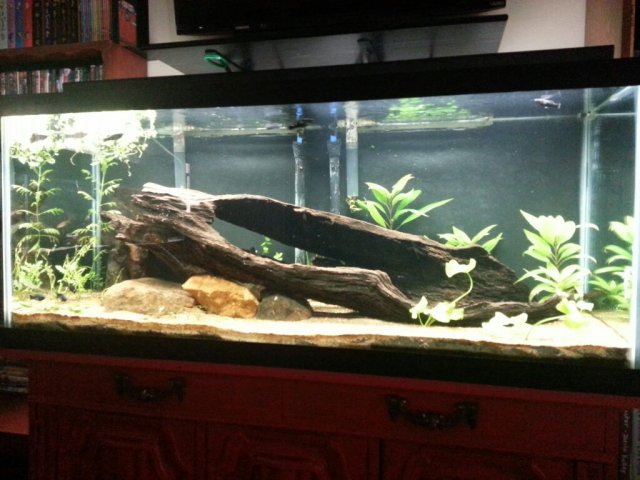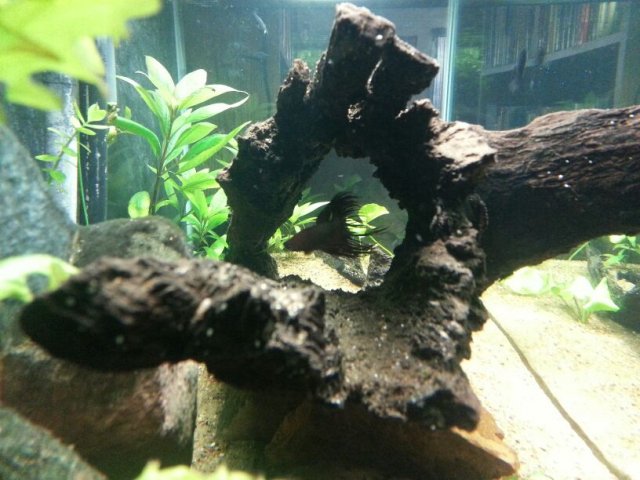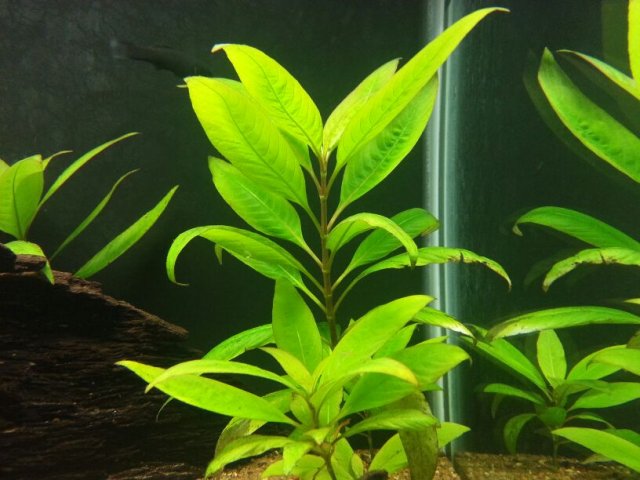Help me identify this plant...
- Thread starter Guenol
- Start date
There might be an identification possible with just the pictures provided, but you could give some observed information about it that would help narrow the possibilities.
How is the stem cross section shaped? Does it have roots growing from the lower stem? How much light do you have and how quickly does it grow x inches? When it reaches the surface does it bend over or easily grow out of the water? Also you might take another picture of it with the camera as close to it as you can get it; ie lens against the glass.
How is the stem cross section shaped? Does it have roots growing from the lower stem? How much light do you have and how quickly does it grow x inches? When it reaches the surface does it bend over or easily grow out of the water? Also you might take another picture of it with the camera as close to it as you can get it; ie lens against the glass.
Agree too, Hygrophila corymbosa.
You asked about what to do when it reaches the surface. If you let it continue to grow--and assuming light and nutrients are adequate for its needs each stem will continue to grow--it will trail along the surface. It might also reach above the surface and grow emersed, as it is a marsh plant in its habitat. In either of these situations, the lower leaves on the stems will likely die off. Like most stem plants, the plant puts its main energy into growth rather than maintaining lower leaves that with less light serve less use for the plant. Alternatively, you can trim the stems and plant the upper portions you cut off as new plants. The lower portion may lose its leaves or may continue and sprout two shoots from the node where it is cut off. Yopu can pull up the lower part and plant the upper portion, thus continually replacing the plants when they reach whatever height you prefer.
Here is a profile I wrote on this plant for another site a couple years ago that may provide more info for you.
Hygrophila corymbosa
Common Name: Giant Hygrophila
Origin and Habitat: Widely distributed throughout SE Asia from India to Indonesia. Occurs in marshes.
Ideal position in aquarium
Excellent as a background plant along the sides and back of the aquarium; different stem lengths can be arranged for a terrace effect but leave 5-6 cm (2 inches) of space between stems.
Lighting requirements
Grows well under moderate light; the shoots will be stronger and thicker under more intense lighting. The reddish variant requires brighter light.
Growth rate
Rapid
Water parameters
Medium-hard to hard (4-15 dGH), slightly acidic to basic (pH 6-8) water, temperature 20-28C/68-82F. May grow best in slightly basic hard water with optimum temperature 24-28C/75-82.
Description
This stem plant is suitable for a plaudarium as well as the aquarium. If allowed to grow emersed, the lower leaves in the water will die off, but the plant will often flower.
Since this is a natural marsh plant, available plants will often have been cultivated emersed by nurseries, and when initially planted in the aquarium the stems frequently lose their existing leaves; new aquatic leaves will appear. As the leaves of this plant are fairly large, the stems should not be planted close together or the lower leaves, being deprived of light, will fall off. Planting other low plants in front of the group of stems, or using a piece of bogwood, will serve to hide the bare lower stems.
Propagation is done by cutting off side shoots (after they are about 4 inches in length and have several nodes from which roots and leaves emerge) and burying the cut ends in the substrate. This is an ideal plant for a new aquarium due to its rapid growth requiring the assimilation of nitrogen (as ammonium) and nutrients which also helps combat algae. It is also a good plant for beginners, as it is hardy and easy to cultivate provided it is regularly trimmed. It needs a good source of nutrients, so regular liquid fertilization is beneficial to maintain a healthy plant; yellowing leaves is usually a sign of insufficient nutrients. A substrate of fine gravel or sand is preferred.
There are several man-made varieties having leaf blades that differ in shape and size. These varieties are sometimes seen under names such as Hygrophila corymbosa "lacustris," H. c. "Siamensis," H. c. "longifolius," H. c. "angustifolia," H. c. "stricta," etc.
This species was first described by Carl Ludwig von Blume in 1826 under the name Nomaphila corymbosa. In 1895, Gustav Lindau determined that the plant was actually in the genus Hygrophila. The genus name comes from the Greek hygros [moist] and philein [to love] and means moisture-loving; all species in the genus prefer moist conditions and naturally grow in swamps and along streams. The species epithet corymbosa is the latinate of corymbous that refers to the inflorescences, meaning a broad and flat-topped cluster of flowers in which the outer flower stalks are longer.
The Acanthaceae or Acanthus family is large, containing some 250 genera with 2650 species; the various plants are flowering and occur in practically every type of habitat; two genera (Justicia and Hygrophila) contain aquatic species. Hygrophila has about 125 species of which roughly 40 are aquatic. Only a few of these are seen in aquaria.
References:
Kasselmann, Christel (2003), Aquarium Plants, English edition.
Wilson, Rhonda (2006), "The genus Hygrophila," Tropical Fish Hobbyist (June 2006).
You asked about what to do when it reaches the surface. If you let it continue to grow--and assuming light and nutrients are adequate for its needs each stem will continue to grow--it will trail along the surface. It might also reach above the surface and grow emersed, as it is a marsh plant in its habitat. In either of these situations, the lower leaves on the stems will likely die off. Like most stem plants, the plant puts its main energy into growth rather than maintaining lower leaves that with less light serve less use for the plant. Alternatively, you can trim the stems and plant the upper portions you cut off as new plants. The lower portion may lose its leaves or may continue and sprout two shoots from the node where it is cut off. Yopu can pull up the lower part and plant the upper portion, thus continually replacing the plants when they reach whatever height you prefer.
Here is a profile I wrote on this plant for another site a couple years ago that may provide more info for you.
Hygrophila corymbosa
[HR][/HR]
Family: AcanthaceaeCommon Name: Giant Hygrophila
Origin and Habitat: Widely distributed throughout SE Asia from India to Indonesia. Occurs in marshes.
Ideal position in aquarium
Excellent as a background plant along the sides and back of the aquarium; different stem lengths can be arranged for a terrace effect but leave 5-6 cm (2 inches) of space between stems.
Lighting requirements
Grows well under moderate light; the shoots will be stronger and thicker under more intense lighting. The reddish variant requires brighter light.
Growth rate
Rapid
Water parameters
Medium-hard to hard (4-15 dGH), slightly acidic to basic (pH 6-8) water, temperature 20-28C/68-82F. May grow best in slightly basic hard water with optimum temperature 24-28C/75-82.
Description
This stem plant is suitable for a plaudarium as well as the aquarium. If allowed to grow emersed, the lower leaves in the water will die off, but the plant will often flower.
Since this is a natural marsh plant, available plants will often have been cultivated emersed by nurseries, and when initially planted in the aquarium the stems frequently lose their existing leaves; new aquatic leaves will appear. As the leaves of this plant are fairly large, the stems should not be planted close together or the lower leaves, being deprived of light, will fall off. Planting other low plants in front of the group of stems, or using a piece of bogwood, will serve to hide the bare lower stems.
Propagation is done by cutting off side shoots (after they are about 4 inches in length and have several nodes from which roots and leaves emerge) and burying the cut ends in the substrate. This is an ideal plant for a new aquarium due to its rapid growth requiring the assimilation of nitrogen (as ammonium) and nutrients which also helps combat algae. It is also a good plant for beginners, as it is hardy and easy to cultivate provided it is regularly trimmed. It needs a good source of nutrients, so regular liquid fertilization is beneficial to maintain a healthy plant; yellowing leaves is usually a sign of insufficient nutrients. A substrate of fine gravel or sand is preferred.
There are several man-made varieties having leaf blades that differ in shape and size. These varieties are sometimes seen under names such as Hygrophila corymbosa "lacustris," H. c. "Siamensis," H. c. "longifolius," H. c. "angustifolia," H. c. "stricta," etc.
This species was first described by Carl Ludwig von Blume in 1826 under the name Nomaphila corymbosa. In 1895, Gustav Lindau determined that the plant was actually in the genus Hygrophila. The genus name comes from the Greek hygros [moist] and philein [to love] and means moisture-loving; all species in the genus prefer moist conditions and naturally grow in swamps and along streams. The species epithet corymbosa is the latinate of corymbous that refers to the inflorescences, meaning a broad and flat-topped cluster of flowers in which the outer flower stalks are longer.
The Acanthaceae or Acanthus family is large, containing some 250 genera with 2650 species; the various plants are flowering and occur in practically every type of habitat; two genera (Justicia and Hygrophila) contain aquatic species. Hygrophila has about 125 species of which roughly 40 are aquatic. Only a few of these are seen in aquaria.
References:
Kasselmann, Christel (2003), Aquarium Plants, English edition.
Wilson, Rhonda (2006), "The genus Hygrophila," Tropical Fish Hobbyist (June 2006).
its a great plant, yours looks good to, just know they are potassium hogs and become MASSIVE (which is why I love them, I like bigger plants)








